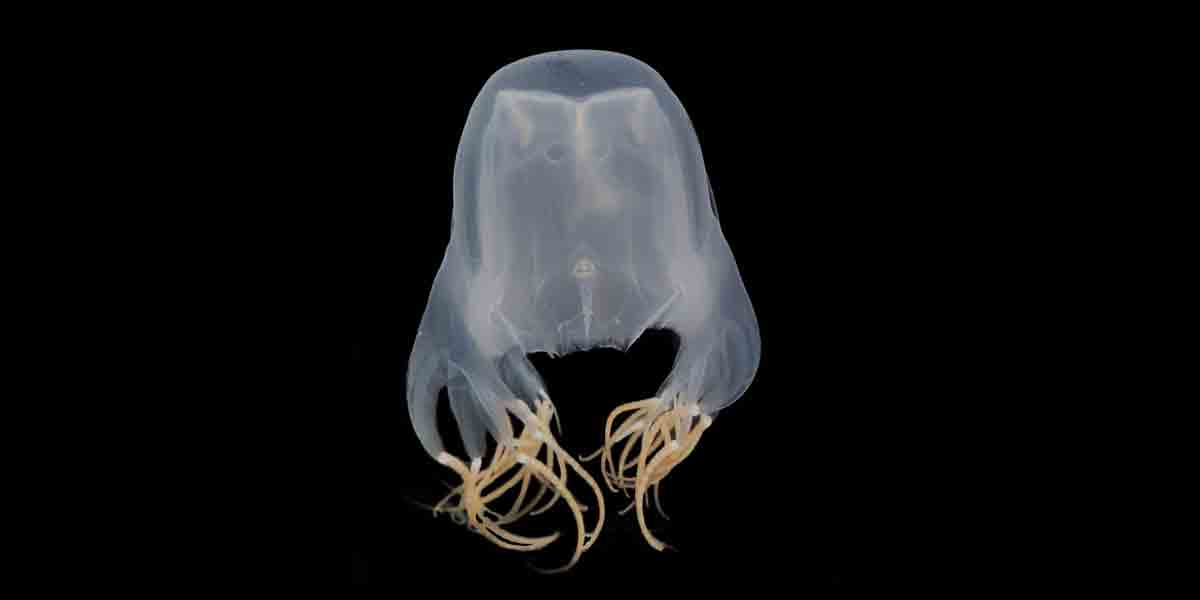A savory explosion of flavors.
This is how the natives of Madalag, Aklan describe their traditional tinuom dish. May it be native chicken, catfish, or shrimp, Madalag’s style of tinuom cooking never fails to tickle the taste bud.
Despite being more than a century’s old, the traditional Tinuom delicacy of Madalag, Aklan remained a staple dish to most of its people.
According to the town’s official records, Tinuom (“to wrap”) is a Madalagnon delicacy that started during the time of Datu Aewag whose reign predates the Spanish era.
Traditionally cooked with native chicken securely wrapped in banana leaves, Madalagnons still celebrate their traditional and ‘authentic’ tinuom dish during fiestas and even on ordinary occasions.
“Dinati pa’t ah ra nga eaha. Sa kapanahunan pat ah it atong mga datu,” said tourism officer Francisco Intela.
(This is an old cuisine, [originated] from the time of our datus [chieftains].)
Without the use of any kitchenware, the banana wrapping is an ingenious way for the locals to cook without having the need to use tools, he stated.
“Ro Madalag abi hay maeayo gid sa syudad. Kumabaga, daya ngara nga putahe hay gin-obra para indi eon baea maggamit it mga kaeaha o euwag. Pagputos mo, diretso eot ah dayun sa baga,” Intela added.
(Madalag is far away from the city. Hence, this cuisine is created so that it wouldn’t require pots or spoons. After wrapping, you can put it directly on the coals.)
ASIDE FROM THE USUAL
Usually, a tinuom dish uses chicken at its main ingredient. This is also the case in Cabatuan, a town in Iloilo which also celebrates its own Tinuom festival.
But aside from the usual native chicken, the Madalag’s version of tinuom also made use of ingredients that are abundant in the river.
“Iya abi sa Madalag, bukon eang it manok atong ginatuom. Ginatuom pat ah naton ru mga sili, bagtis, ag mga ueang. Maeapit abi kita sa suba kaya ru mga ingredients man nga mabuoe sa suba, ginatuom man naton,” Escot said.
(Here in Madalag, we don’t only cook the native chicken. We also cook the catfishes and shrimps. We are near the river so it makes sense that the ingredients we get from there are also cooked [as tinuom].)
Madalag is situated in the south-central part of the province and surrounded by the Aklan River. Its geophysical characteristics made ingredients from the river available for consumption, he added.
Intela also explained the difference of the Madalag’s tinuom from its Ilonggo counterpart.
“Tag sa Cabatuan, ginasteam ah nanda ru andang tinuom. Ginabutang sa kaeaha, duyon mat ah andang version kumbaga. Iya sa aton, gindiretso eat ah sa baga ru pageaha, uwa eot ah ginapasteam or ginabutang sa kaeaha,” he stated.
(In Cabatuan [Iloilo], they steam their tinuom. They put it in the pot – that’s their own version of it. Here, we directly put the tinuom in charcoal. We don’t steam or put the tinuom in the pot.)
Steaming the tinuom, he said, is a more ‘modern’ method of cooking the dish.
He also explained that a technique has been developed so that the leaves don’t burn too much when placed in the coals.
“Diretso eot ah sa baga atong pageaha iya. Ag syempre, may mga technique man kita kung paano indi masunog ru dahon bisan diretso imaw sa baga,” Intela explained.
(We put the tinuom directly in the coal but of course we also developed techniques so that the banana leaves don’t burn too much during the cooking.)
COOKING THE TINUOM

Cooking the tinuom entailed simple ingredients. These typically include small slices of native chicken, tanglad (lemon grass) and pinches of salt, pepper, onion and garlic.

meat to cook properly.
“Ieintukon du manok, kasarangan eang it eagko. Dapat hiwaon ru manok nga madya tig daywa ka tudlo it eagko agud maeaha gid,” Madalagnon native and culinary student, Romeo Rafols explained.
(Slice the chicken in small pieces. The chicken needed to be sliced almost as the size of a one to two fingers for it to cook properly.)
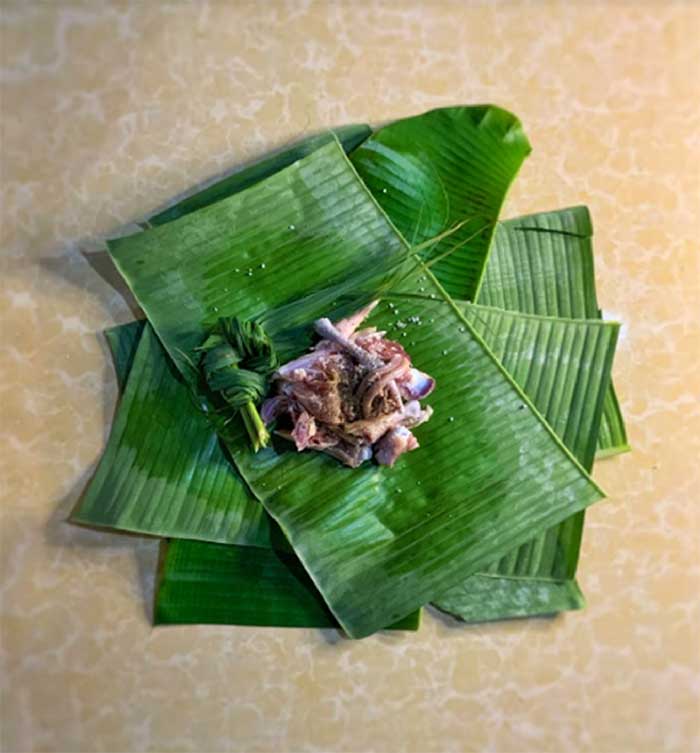
“Ihalo ru tanan nga ingredients ngato ag iputos sa tig sambilog o daywa nga sapad it dahon it saging,” he added.
(Mix in all the ingredients [native chicken, tanglad/lemon grass, and pinches of salt, pepper, onion and garlic] and wrap them securely in 1-2 plies of banana leaves.)
With regards to adding water, Rafols clarified that the traditional recipe does not require any water because the chicken itself can be cooked without water. The moisture from the chicken allows for it to be cooked without water.
“Kung sa traditional gid, uwa ah kita gabutang it tubi, pero depende man sa preference it iba. Kung gusto nanda may sabaw, pwede magbutang it 1-2 cups of water, pero traditionally hay uwa gabutang it tubi dahil gaeaha mat ah ru manok sa anang moisture,” he explained.
(Traditionally, we don’t add water, but it still depends on the preference [of the cook]. If they want broth in their dish, they can add at least 1-2 cups of water. But traditionally, we don’t do this because the chicken’s moisture is enough to cooks the dish.)
Before wrapping the ingredients with the banana leaves, however, Rafols said that the banana leaves must be glazed slightly above the flames so that it wouldn’t tear during the cooking.
“Bago mo iputos ru tanan hay dapat eahubon mo anay. Paagyan anay sa kaeayo agud indi magisi kung ibutang eon sa baga,” he said.
(Before wrapping, glaze the leaves slightly above the flames (Eahob). The leaves must be glazed so that we prevent tearing in the leaves when the we put it (tinuom) in the coals.)\
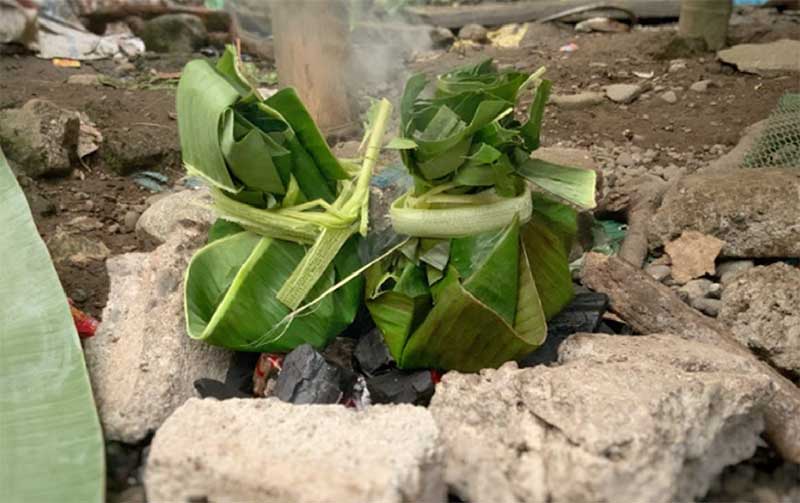
“Pagkatapos mo it putos hay ibutang mo eon dayun sa baga. Hueaton mo lang dayun mageaha mga 1-2 hours. Depende pa kung mauno it gueang ing manok,” he added.
(After wrapping the tinuom, put it directly on the coals. Wait for it to cook which will usually take 1-2 hours. Depends on the age of the chicken.)
Rafols also said that during cooking, one must make sure that the dish remains seated in the coals and not let the dish get flamed.
“Una eat ah dapat imaw sa baga ag indi pagpadabdabon gid. Hueat lang dayun nga maeaha,” he stated.
(Put it in the coal and don’t let it get flamed. And then wait for it to get cooked.)
After 1-2 hours, the tinuom will then be ready to serve.

TINUOM FESTIVAL
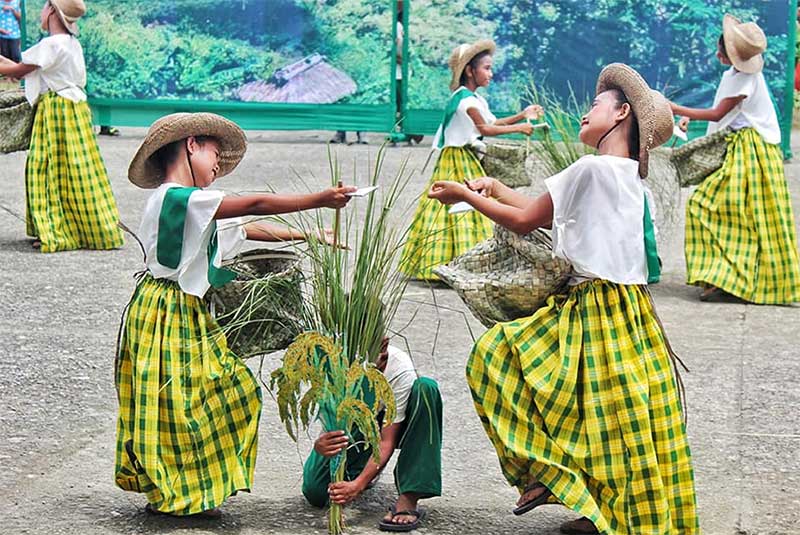
Madalag celebrates its traditional tinuom dish during the Tinuom Festival held every 29th of July.
The festivities included street dancing, larong lahi, Ms. Tinuom coronation and tinuom cooking competitions. A parade of street performers wearing colorful costumes marks the start of the festival and culminate in an awarding ceremony for all the winners of the contests held a day prior.
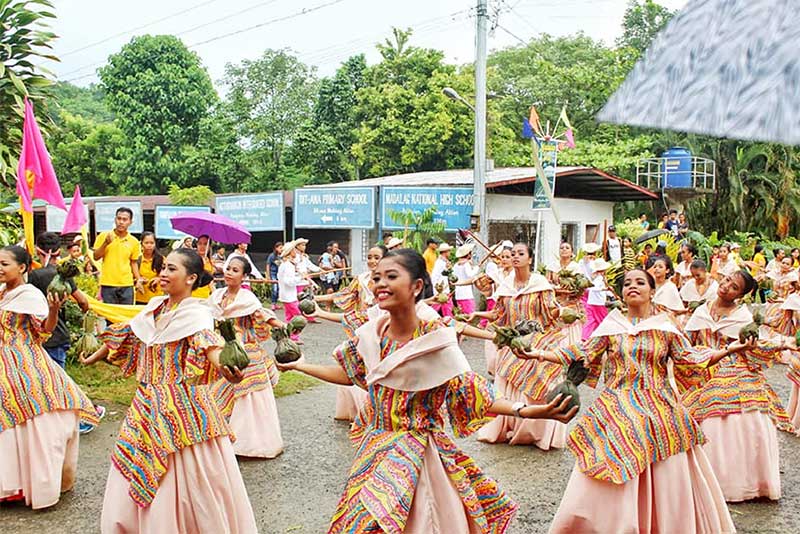
Among the highlight of the events is the dance competition where participants wear extravagant and colorful costumes and perform dances with choreographies that imitate the process of traditional tinuom cooking.
The winning group of the 2019 Tinuom festival from Madalag National High School performed a dance routine which centers on the step by step cooking process of the tinuom as reflected in their choreography, props, and costumes. Their performance is accompanied by percussion instruments to evoke a sense of tradition.
The first tinuom festival was held on July 19, 2015 and has continued since then except last year because of the COVID 19 pandemic.
CULTURAL TRADEMARK
Mayor Al Dindo Gubatina underscored the importance of celebrating the tinuom as the town’s ‘authentic trademark’.
“Ginapakita naton ru atong kultura, kung paano mageaha atong forefathers ag ro mga ginakaon kato. Ginapresent naton du pagkaon nga unique sa aton and at the same time, ginapresent man naton atong kultura as a Madalagnon,” Gubatina said.
(We show our culture, how our forefathers cook their meals. We also present a dish that is unique to us and at the same time, we also present out culture as a Madalagnon.)
“Kara abi kita nakilaea. Kumbaga may aton eon nga name recall. ‘Pag hinambae nga tinuom, ay sa Madalag run. Kung sa mga kaeapit banwa ta, pag hinambae nga tinuom, sayod nga sa Madalag run,” he added.
(This (tinuom) is what we are known for. This is our name recall. When they say tinuom, they know it’s in Madalag. For our neighboring towns, when one says tinuom, they already know that it’s from Madalag.)
He also expressed his aspiration for the next generation to learn this culture and to continue the long tradition of tinuom as a cultural symbol for Madalag.
“Ag sa mga ulihi, kung uwa eon kami, kunta magpadayon gihapon raya nga tradisyon nga ginpamana pa’t ah katon it atong mga ninuno,” he stated.
(In the end, when we no longer live in this world, I hope that this tradition still continues…a tradition that we have inherited from our forefathers.)





















